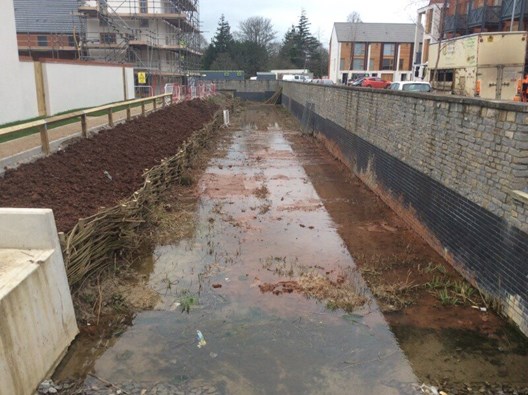In January 2023, Defra announced a decision to implement Schedule 3 of the Flood and Water Management Act 2010 in England. This will introduce a new framework and national standards for the approval and adoption of SuDS in England, and will make Unitary and County Councils SuDS Approving Bodies. The UK Government is currently considering how Schedule 3 will be implemented.
Maintaining SuDS
The maintenance and adoption of SuDS should be considered at the pre-application stage of a development. It is important to consider:
It is important to consider:
- Who will manage and maintain the SuDS features?
- How will they maintain the SuDS features?
Above ground features such as swales and basins can be maintained as part of general landscaping contracts. This often makes them cheaper and easier to maintain than piped networks and underground components. Underground components, particularly those involving deep excavation, should be avoided, through early consideration of operational and maintenance requirements.
Maintenance of SuDS should be simplified and practical. Management of SuDS features within a site by multiple organisations is not an efficient use of resources.
The table below shows an overview of the types of activities and the frequency they are required to keep SuDS maintained.
|
Regular maintenance (Daily or monthly activities) |
Occasional maintenance (Frequency determined for each site) |
Remedial maintenance |
|
|
|
Further detail can be found in the Susdrain Maintenance of SuDS and Maintenance and Adoption Factsheet resources.
Designing for maintenance
 The Somerset Local Design Standards (L17) recognise the importance of the sustainable long-term maintenance and management of a SuDS scheme. Maintenance is critical to effectiveness and success of SuDS, for example ensuring that the system drains effectively, and the created habitats sustain wildlife. These requirements should be considered from the outset of the design process, and cover the lifetime of the development.
The Somerset Local Design Standards (L17) recognise the importance of the sustainable long-term maintenance and management of a SuDS scheme. Maintenance is critical to effectiveness and success of SuDS, for example ensuring that the system drains effectively, and the created habitats sustain wildlife. These requirements should be considered from the outset of the design process, and cover the lifetime of the development.
Piped networks and underground features, particularly involving deep excavation, should be avoided, through early consideration of operational and maintenance requirements. Shallow surface features are preferred, with easily visible inlets and outlets where problems can be easily identified and systems designed to prevent blockages.
Further detail is given under Somerset Local SuDS Standard L17 and within the Susdrain Maintenance and Adoption Factsheet.
Maintenance and Operation Plan
All outline and full planning applications for Major developments in Somerset must provide a Maintenance and Operation Plan. This will demonstrate that the proposed SuDS can be easily and safely maintained by the adopting organisation. A maintenance plan must comply with the Somerset Local Design Standards, as set out in Standard L17. Note that different adopting authorities, such as Wessex Water and Somerset County Council Highways, may have additional maintenance design requirements for adoptable SuDS.
 Sediment washed into rill in new development
Sediment washed into rill in new developmentA Maintenance and Operation Plan should be at an appropriate level of detail for the planning stage including:
- Details of the required regular, occasional, and remedial maintenance activities for all SuDS features on the site. The plan should be tailored to the actual SuDS features planned for the site and how they should be maintained in the specific setting of the development. The feature-specific maintenance tables in Chapter 32 of the CIRIA SuDS Manual can be used to inform the plan, but simply reproducing them is not acceptable.
- Estimated costs for the specified maintenance activities.
- Details of any establishment maintenance activities required over the first 5 years.
- Locations of access points for maintenance of the SuDS features.
- Identification of a specified management authority for each SuDS feature for the lifetime of the development and details of adoption arrangements.
- Where multiple maintenance organisations are identified, details of how maintenance plans will be coordinated, to maintain performance of the SuDS network.
- Details of how the maintenance plans will be communicated effectively to residents. This should include:
- What SuDS are present
- How they work
- What defects to look out for
- Who to contact in the event of a problem
Further guidance including a sample maintenance plan and inspection checklist (Appendix B) can be found in Chapter 32 of the CIRIA SuDS Manual. However, this is a guide only and the maintenance plan is likely to differ from one site to another. Careful consideration is required to ensure that the maintenance plan is site-specific.

